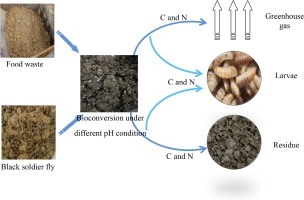当前位置:
X-MOL 学术
›
J. Environ. Manag.
›
论文详情
Our official English website, www.x-mol.net, welcomes your
feedback! (Note: you will need to create a separate account there.)
Reducing greenhouse gas emissions and enhancing carbon and nitrogen conversion in food wastes by the black soldier fly.
Journal of Environmental Management ( IF 8.0 ) Pub Date : 2020-01-16 , DOI: 10.1016/j.jenvman.2020.110066 Wancheng Pang 1 , Dejia Hou 2 , Jiangshan Chen 1 , Elhosseny E Nowar 3 , Zongtian Li 1 , Ronggui Hu 4 , Jeffery K Tomberlin 5 , Ziniu Yu 1 , Qing Li 1 , Shucai Wang 6
Journal of Environmental Management ( IF 8.0 ) Pub Date : 2020-01-16 , DOI: 10.1016/j.jenvman.2020.110066 Wancheng Pang 1 , Dejia Hou 2 , Jiangshan Chen 1 , Elhosseny E Nowar 3 , Zongtian Li 1 , Ronggui Hu 4 , Jeffery K Tomberlin 5 , Ziniu Yu 1 , Qing Li 1 , Shucai Wang 6
Affiliation

|
Currently, sustainable utilisation, including recycling and valorisation, is becoming increasingly relevant in environmental management. The wastes bioconversion by the black soldier fly larva (BSFL) has two potential advantages: the larvae can convert the carbon and nitrogen in the biomass waste, and improve the properties of the substrate to reduce the loss of gaseous carbon and nitrogen. In the present study, the conversion rate of carbon, nitrogen and the emissions of greenhouse gases and NH3 during BSFL bio-treatment of food waste were investigated under different pH conditions. The results showed that the pH of the raw materials is a pivotal parameter affecting the process. The average wet weight of harvested BSFL was 13.26-95.28 mg/larva, with about 1.95-13.41% and 5.40-18.93% of recycled carbon and nitrogen from substrate at a pH from 3.0 to 11.0, respectively. Furthermore, pH is adversely correlated with CO2 emissions, but positively with NH3 emissions. Cumulative CO2, NH3, CH4 and N2O emissions at pH ranging from 3.0 to 11.0 were 88.15-161.11 g kg-1, 0.15-1.68 g kg-1, 0.19-2.62 mg kg-1 and 0.02-1.65 mg kg-1, respectively. Compared with the values in open composting, BSFL bio-treatment of food waste could lead greenhouse gas (especially CH4 and N2O) and NH3 emissions to decrease. Therefore, a higher pH value of the substrate can increase the larval output and help the mitigation of greenhouse gas emissions.
中文翻译:

黑人士兵的飞行减少了温室气体的排放,并提高了食物垃圾中的碳氮转化率。
当前,可持续利用,包括回收利用和增值,在环境管理中变得越来越重要。黑士兵蝇幼虫(BSFL)进行的废物生物转化具有两个潜在的优势:幼虫可以转化生物质废物中的碳和氮,并改善基质的性能以减少气态碳和氮的损失。在本研究中,研究了在不同pH条件下BSFL生物处理餐厨垃圾过程中碳,氮的转化率以及温室气体和NH3的排放。结果表明,原料的pH是影响工艺的关键参数。收获的BSFL的平均湿重为13.26-95.28 mg /幼虫,在pH为3的情况下,约有1.95-13.41%和5.40-18.93%的回收碳和氮从基质中回收。0到11.0。此外,pH与CO2排放呈负相关,但与NH3排放呈正相关。pH在3.0到11.0范围内的累积CO2,NH3,CH4和N2O排放分别为88.15-161.11 g kg-1、0.15-1.68 g kg-1、0.19-2.62 mg kg-1和0.02-1.65 mg kg-1 。与露天堆肥相比,BSFL对食物垃圾的生物处理可能导致温室气体(尤其是CH4和N2O)和NH3排放量减少。因此,较高的底物pH值可以增加幼虫的产量,并有助于减少温室气体的排放。分别。与露天堆肥相比,BSFL对食物垃圾的生物处理可能导致温室气体(尤其是CH4和N2O)和NH3排放量减少。因此,较高的底物pH值可以增加幼虫的产量,并有助于减少温室气体的排放。分别。与露天堆肥相比,BSFL对食物垃圾的生物处理可能导致温室气体(尤其是CH4和N2O)和NH3排放量减少。因此,较高的底物pH值可以增加幼虫的产量,并有助于减少温室气体的排放。
更新日期:2020-01-17
中文翻译:

黑人士兵的飞行减少了温室气体的排放,并提高了食物垃圾中的碳氮转化率。
当前,可持续利用,包括回收利用和增值,在环境管理中变得越来越重要。黑士兵蝇幼虫(BSFL)进行的废物生物转化具有两个潜在的优势:幼虫可以转化生物质废物中的碳和氮,并改善基质的性能以减少气态碳和氮的损失。在本研究中,研究了在不同pH条件下BSFL生物处理餐厨垃圾过程中碳,氮的转化率以及温室气体和NH3的排放。结果表明,原料的pH是影响工艺的关键参数。收获的BSFL的平均湿重为13.26-95.28 mg /幼虫,在pH为3的情况下,约有1.95-13.41%和5.40-18.93%的回收碳和氮从基质中回收。0到11.0。此外,pH与CO2排放呈负相关,但与NH3排放呈正相关。pH在3.0到11.0范围内的累积CO2,NH3,CH4和N2O排放分别为88.15-161.11 g kg-1、0.15-1.68 g kg-1、0.19-2.62 mg kg-1和0.02-1.65 mg kg-1 。与露天堆肥相比,BSFL对食物垃圾的生物处理可能导致温室气体(尤其是CH4和N2O)和NH3排放量减少。因此,较高的底物pH值可以增加幼虫的产量,并有助于减少温室气体的排放。分别。与露天堆肥相比,BSFL对食物垃圾的生物处理可能导致温室气体(尤其是CH4和N2O)和NH3排放量减少。因此,较高的底物pH值可以增加幼虫的产量,并有助于减少温室气体的排放。分别。与露天堆肥相比,BSFL对食物垃圾的生物处理可能导致温室气体(尤其是CH4和N2O)和NH3排放量减少。因此,较高的底物pH值可以增加幼虫的产量,并有助于减少温室气体的排放。











































 京公网安备 11010802027423号
京公网安备 11010802027423号